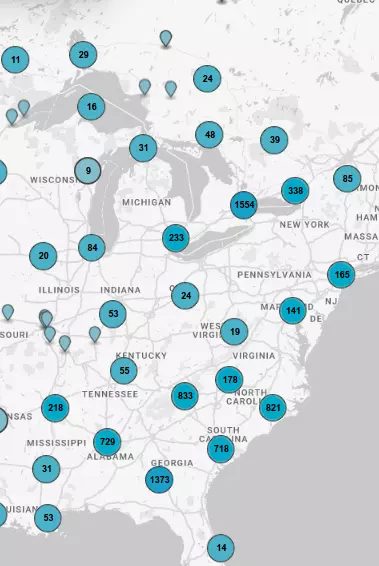King's College
The first university in the province, King's College was chartered in 1827 through the efforts of the Reverend John Strachan. This site was acquired by the College the following year. Sectarian...
- toronto
- ontario
- alan brown
Knox Church
Knox Presbyterian Church was organized in 1848 with forty members, and a small frame church was built here on .4 ha of land given by Thomas Kennedy. Its first elders were local farmers: Wm. Clark,...
- toronto
- ontario
- alan brown
Kay Gardner Beltline Park
Originally opened in 1892 to serve the expanding suburbs of Moore Park and Forest Hill, the circular Beltline railway closed its passenger service just two years later. The final section was...
- toronto
- ontario
- alan brown
King Street West Railway Subway (Underpass) 1888
This railway underpass is one of the oldest in the City of Toronto. Rail lines were first built through this area in the 1850s, connecting Toronto to the upper Great Lakes and points in-between....
- toronto
- ontario
- alan brown
King Street Carhouse
For over three decades, this was the site of the King Street Carhouse, once the largest streetcar facility in the city. The first railway stables on this site were constructed in 1887 by the...
- toronto
- ontario
- alan brown
Knox College
Founded in 1844 by the Free Presbyterian Church as a seminary, Knox College was named in 1846 to honour Scottish reformer John Knox. After the 1861 union of Presbyterians, it remained as the...
- toronto
- ontario
- alan brown
Kay Gardner Beltline Park
The Belt Line is the name given to a railway line that encircled Toronto and was completed in 1892. The Toronto Belt Line Railway Company proposed to generate and exploit a real estate boom in...
- toronto
- ontario
- alan brown
Kempton Howard Park
Kempton Howard grew up in the Blake/Boultbee community. Kempton was a talented and respected youth leader and mentor. He was a part-time staff person at the Boys and Girls Club at...
- toronto
- ontario
- alan brown
The Kingston Road Radial
In 1875 the Kingston Road Tramway opened a horsecar line between the Don River and Main St., extended in 1878 to Blantyre Ave. Operations ceased in 1887. On July 1, 1893 the Toronto and Scarboro'...
- toronto
- ontario
- alan brown
Kew Williams House 1902
Kew Williams (1873-1956) built this house for his wife, Bertha Curran, in The Canadian Kew Gardens, a campground resort opened in 1879 by his parents, Joseph Williams and Jane Henry. Using mostly...
- toronto
- ontario
- alan brown
Keating Coffee House
On this site in 1833 stood Keating Coffee House, also known as York's Fourth Theater. In the back hall that was about 20 m long and held two to three hundred people theatrical and...
- toronto
- ontario
- alan brown
The King Edward Hotel
The King Edward Hotel was built by George Gooderham's Toronto Hotel Company to meet the demand in the rising metropolis for a grand hotel. When it opened in 1903, the hotel, affectionately known...
- toronto
- ontario
- alan brown
Knesseth Israel Synagogue
"The Junction Shul" was founded early in the 20th century in a building at the corner of Maria Street and Runnymede Road, with a congregation primarily of Polish and Russian Jews. As...
- toronto
- ontario
- alan brown
The King's Mill
For thousands of years, the Humber River served as a corridor for Aboriginal settlement and trade. In late 1793, only a few months after British officials founded the Town of York (now...
- toronto
- ontario
- alan brown
Joseph Shepard
The Joseph Shepard Building is named after one of York's first settlers. Joseph Shepard was a fur trader, an outstanding pioneer who helped build some of the first houses in this area when...
- toronto
- ontario
- alan brown
June Rowlands - Dedicated Leader and Woman of "Firsts"
For more than four decades, June Rowlands served the people of Toronto with passion, vision and commitment. Her impressive record of public service began as President of the Association of Women...
- toronto
- ontario
- alan brown
J.B. Tyrrell (1858-1957)
Joseph Burr Tyrrell, explorer and mining engineer, was born in Weston, Ontario on 1 November 1858. After graduation from the University of Toronto he joined the Canadian Geological Survey in 1881....
- toronto
- ontario
- alan brown
James Bryce Milner Park
A native of Nova Scotia, James Bryce Milner (1918-1969) was professor of law at the University of Toronto and an internationally-recognized authority on town planning law. A member of several...
- toronto
- ontario
- alan brown
James Mavor Moore CC D.Litt LL.D FRSC 1919-2006
Dramatist, composer, producer, director, actor, educator and arts advocate, Mavor Moore passionately believed Toronto deserved a performing arts centre. Canada's Centennial in 1967 provided the...
- toronto
- ontario
- alan brown
John M. Lyle Studio 1921
This façade was part of a studio designed by John M. Lyle for his architectural practice. Lyle, one of Canada's most distinguished architects, trained a number of noteworthy Canadian architects at...
- toronto
- ontario
- alan brown
